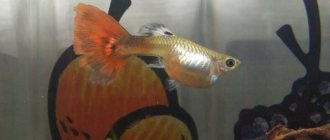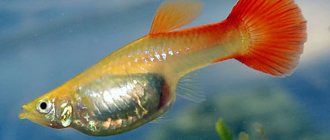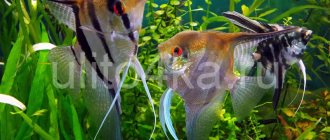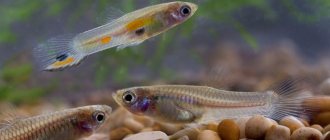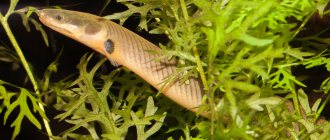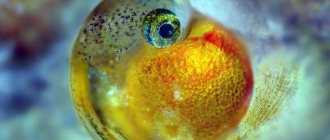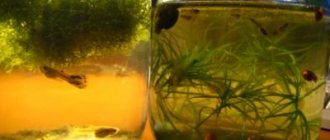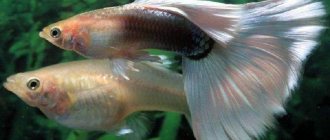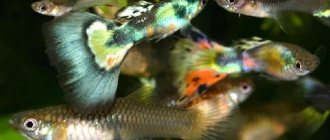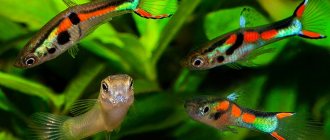Barbs are a type of aquarium fish. Among the other inhabitants of the home pond, they stand out for their bright beauty and rather aggressive character. Barbs get along in an aquarium with many species, but there are also those towards whom they show cockiness and aggression. Therefore, if the aquarium is already populated with fish, a novice aquarist should be aware of the compatibility of barbs with other types of fish.
Barbs are very beautiful aquarium inhabitants; they behave very aggressively with some types of fish.
Maintenance and care
Barbs are not so demanding, so keeping them will not be particularly difficult even for beginner aquarists. They live in the lower and middle layers of water. Small species live in flocks of 5–7 individuals. In addition, the fish also bring benefits: they collect leftover food from the bottom. They are constantly busy with something, trying to find something edible in the soil. They also have excellent hearing due to the fact that they have a special Weber hearing aid.
Small species are best kept in an oblong aquarium of 50 liters or more. It is recommended to keep small species (less than 5 cm long) in a 50–100 liter aquarium. In an aquarium for barbs with a capacity of 100–200 liters – medium species (fish that are 7–8 cm long). But large species (15–30 cm) are best planted in an aquarium of 200 liters or more.
One barb will not feel very comfortable, so it is better to breed them in a flock of 5-7 pieces in one aquarium.
Aquarium fish barbs love water with current. Filtration is mandatory, and weekly water changes of 20% are recommended. If the fish begins to swim near the surface of the water, you need to urgently change the water.
Water requirements:
- Water temperature – 19–25 °C (tolerates up to 17 °C).
- Neutral water, acidity: 6.5–7.5
- Hardness – 4–10°.
It is recommended to densely plant dense plants in the aquarium, but leave the central part of the aquarium free. They quickly begin to destroy tender plants. Plants for barbs in an aquarium can be:
- Hard-leaved Anubias.
- Cryptocorynes.
- Vallisneria.
- Arrow leaf.
- Elodea.
- Echinodorus.
- Cabomba.
- Myriophyllum.
- Floating mosses: Thai and Java moss, hornwort, pinnate, nayas, fontinalis moss.
They don’t really like bright light, so it is advisable to have floating algae on the surface.
Sand or gravel can be used as soil. If you choose a darker soil, the color of the scales will be brighter.
You can often find that a school of fish huddles in some corner and does not move, while the fish are all tilted down. This behavior is quite normal, there is no need to worry about it. But if the fish tilt more than 45 degrees, then you need to check the conditions in the aquarium, because something is clearly not according to the standards.
Reproduction
Even a novice aquarist can breed barbs. With proper feeding, after 7 months the fish reach puberty and the fish are ready to reproduce. If desired, individuals of different sexes are placed in different tanks so that the female can collect eggs, but this is not necessary. The water temperature is maintained at 23 degrees.
Sex differences
It is almost impossible to distinguish between a male and a female Sumatran barb at a young age. A visible difference appears as the barb's breeding season approaches. Females' bellies become noticeably rounder, while males stretch out and become slimmer. And also the color of males is more distinguished by its beauty and brightness.
Spawning
To lay eggs you will need a separate spawning tank of about 15 liters. Soil is not necessary; moss or synthetics will do. A net is placed at the bottom so that the eggs fall there and the parents do not eat them. The temperature in the spawning tank is raised to 26 degrees. Closer to the morning the spawning process begins. It does not last long, a few hours, but the female lays about 600 eggs.
After spawning, the parent Sumatran barbs are removed from the spawning tank and moved to a common aquarium. It is advisable to replace some of the water with clean water. The eggs should not be exposed to sunlight or direct light. After a couple of days, the larvae hatch, which after another few days turn into fry. At this time, the fry become active and require food. The fry do not need special care; you just need to feed them frequently and change the water.
What to feed barbs
Fish are omnivores, so they can be fed frozen, dry or live foods. Suitable live foods include: tubifex, daphnia, bloodworms, cyclops, and brine shrimp. Branded food in the form of tablets and granules is also suitable. Cover the aquarium with a lid, because while feeding, barbs are quite active and can jump out of it.
Adults, so that they do not destroy the plants in the aquarium, should be given cucumbers, zucchini, lettuce, dandelion leaves, nettles, dried algae, spinach or wolfberry.
Feed small portions, without overeating, as this will only harm the health of the fish. This needs to be carefully monitored, because fish are prone to obesity, so it is better to underfeed them once again. You can have a fasting day once a week. Although they love to eat from the bottom, it is advisable to remove any leftover food from the aquarium.
And just don’t forget that food for barbs should be varied.
Adviсe
- Do not overfeed barbs.
- Plant a sufficient number of plants.
- Choose a shallow aquarium rather than a long one.
- Do not share with slow and stately fish.
- Do not share with small fish or fry.
The Sumatran barb will enliven any aquarium with its cheerful temperament and will be an excellent decoration. If it seems to you that the aquarium has become slow and lifeless, then buy a barb. These fish will quickly create vigorous activity in the water; all you have to do is watch them.
(Visited 358 times, 1 visits today)
Compatibility
If improperly settled, barbs behave quite aggressively. Conflicts can occur both within the school and spread to other fish. For example, if there is a smaller or slower fish in the aquarium, then there will most likely be a conflict. It happens that fish just may not agree on their personalities. They get along well with fish, who can also fend for themselves. But large species can become competitors for comparable individuals. They may begin to eat the fins of cichlids, giant gouramis, and goldfish.
Aquarium barbs are not predators, but if fry of other fish appear, they instantly swallow them.
Due to the fact that the fish are very mobile and move in schools, they can cause discomfort and stress in the other inhabitants, so they do not get along with everyone.
Barbs get along with the following fish:
- Botia the clown.
- Gourami.
- Large tetras.
- Labeo.
- Pecilia.
- Danio.
- Cichlazoma.
- Swordtails (sometimes, but there are cases when they lived together).
But it’s worth clarifying that with gourami everything is not so simple. Because it all depends on the type of barbs you have in the aquarium. Before purchasing, it is better to clarify in advance whether this species is suitable for gourami. For example, Sumatran and mutant will get along well with gouramis.
They do not get along with long-finned fish, as well as small representatives.
They do not get along with barbs:
- minors;
- rasboras;
- Corydoras catfish;
- thorns;
- cichlids;
- telescopes;
- mollies;
- angelfish;
- guppy;
- neons;
- shrimps.
Here is a general description and it may vary slightly from species to species.
Description
Sumatran pumpius or barb is a species of fish from the order Cyprinidae and the class Ray-finned fish.
In nature, it lives in the waters near the islands of Kalimanan and Sumatra, which is why it got its name. In the European part, they first learned about pumpius in 1935. The species became widespread in Russia in 1947. They prefer quiet, medium-sized rivers with weak currents, clear water and a sandy bottom in the thick of the jungle.
Appearance
The body of the Sumatran is tall, slightly reminiscent of a circle, and the head is sharp. The size of a barb in nature is usually 7 cm; in captivity these fish are even smaller. The body color is pale yellow with red splashes. Feature: 4 vertical black stripes on the body. One of the stripes always passes through the eye of the fish, the second - in front of the dorsal fin, the third - near the anal fin, and the last one in front of the caudal fin. There is a red border on the dorsal fin.
Behavior
Barbs are active inhabitants and have quite aggressive behavior towards other species and individuals of their own species. A strict hierarchy is built in the school, in which each fish has its own specific place. If some fish does not want to be in the hierarchy, then it is severely punished.
During sleep and rest, they hover in the water column and lower the front part of their body down, being at an acute angle to the bottom. Some aquarists think that this is how the fish shows its poor health, but this is not so.
Lifespan
Sumatrans are not known for their longevity. The average lifespan is 5 years, but fish die earlier due to improper maintenance or overfeeding.
Conclusion
Barbs are perfect for keeping in an aquarium for those who love sharp, nimble, active fish. They are not so whimsical in their maintenance; they like to live in a flock. They are not aggressive, but can sometimes be aggressive within a species or on other fish (just make sure that the fish are truly compatible with each other, although they can get along with many species). Small species live up to 5 years, which can delight you for a long time in your aquarium!
Previous FishTips for keeping a large cleaner - brocade catfish! Next
FishHow to keep one of the most popular fish, guppy
Kinds
In addition to Sumatran, other types are also common:
- Albino. The albino Sumatran barb was artificially bred. Differs in white-beige color.
- Fire barb. Lives in water bodies of India. It has an elongated body and orange-red color of skin and fins.
- Cherry. Lives in Asia. The back is brownish, the sides are crimson with dark stripes and spots.
- Mutant. It has one of the most unusual colors. The mutant has a combination of blue, green and black colors with orange fins and snout.
- Denison. Named after Sir William Denison. The body is elongated. Black and red stripes run from the sides of the head, the lower part is pale yellow, and the upper part is bluish.
Cockerel
Betta fish (Betta splendens), the name speaks for itself. But, he can get along wonderfully in a community aquarium. As always, simple rules: do not keep two males in an aquarium, they will fight to the death.
Females can get it too, so create hiding places for them. Do not keep them with fish of similar color, they may confuse them with their opponents and attack. And it is advisable to avoid other labyrinths, such as marbled gouramis, as they have similar habits and territoriality.
Habitat in nature
These cyprinids have been a very popular aquarium fish for a long time, and do not lose their popularity. They received their specific name because they originate from the island of Sumatra.
Of course, they have not been caught in the wild for a long time, but are successfully bred both in Southeast Asia and throughout Europe. Moreover, several artificially bred forms already exist - albino, with veil fins and green.
It was first described by Blacker in 1855. It is native to the islands of Sumatra and Borneo, and is also found in Cambodia and Thailand. Initially, it was found only in Borneo and Sumatra, however, it was artificially introduced. Several populations even live in Singapore, Australia, the USA and Colombia.
In nature, they live in quiet rivers and streams located in dense jungle. In such places there is usually very clean water with a high oxygen content, at the bottom there is sand, as well as stones and large snags.
In addition, the number of plants is very dense. In nature they feed on insects, detritus, and algae.
Diseases
Despite the easy maintenance of barbs, the fish often die due to improper conditions. Given that punts are prone to gluttony, the phenotypes suffer from obesity, which is the most common cause of death in pets.
In addition to this disease, barbs are susceptible to rubella, a dangerous disease. Pets can become infected from a neighbor, untreated soil or plants. The symptoms of the disease are pronounced: the eyes of the fish bulge, ulcers form on the body, and the abdomen swells. As the disease develops, the fish refuse to eat, and then the disease leads to death. To save barbs, aquarists use methylene blue, making baths and dipping sick pets into them.
In addition to diseases, the reason for the deterioration of the condition of fish is the crossing of close relatives. In this case, barbs may be born with anomalies and pathologies.
Sumatran barbs are playful and active fish that will not let aquarium residents get bored. Considering the interesting behavior of striped puntius, as well as easy care and maintenance, for many aquarists the Sumatran barb is a sought-after and desirable resident.
Notes
It should be noted that in nature it has a more faded color than its aquarium relative.
The fish that can now be found on sale were obtained, as a rule, as a result of aquarium breeding, and the brightness of their color was enhanced by long-term selection. A mutation in the color of the Sumatran barb can be caused, for example, by exposure of eggs to ultraviolet rays, as well as a sharp change in various water parameters in the spawning area (temperature, pH or hardness). Mutants and albinos are weaker and more finicky fish compared to their natural form.
The genus of “Sumatran” barbs (Puntigrus) is currently represented by five species. The genus Puntigrus was created by Maurice Cottela (2013) to house a group of species previously called the "Puntius tetrazona group". Other members are P. anchisporus, P. navjotsodhii, P. pulcher and P. partipentazona, the first three of which are endemic to western, central and eastern Borneo respectively, and the last to Indochina.
Sumatran barb (Puntigrus tetrazona) was previously referred to as Puntius tetrazona, Systomus tetrazona or Capoeta tetrazona.
